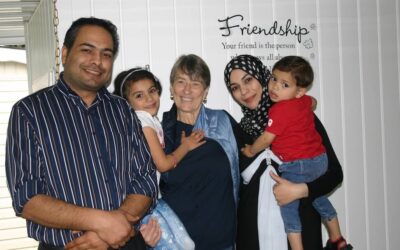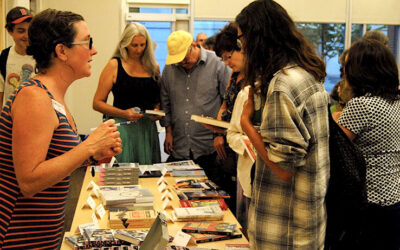It’s been a labour of love – we chip away at it piece by piece.
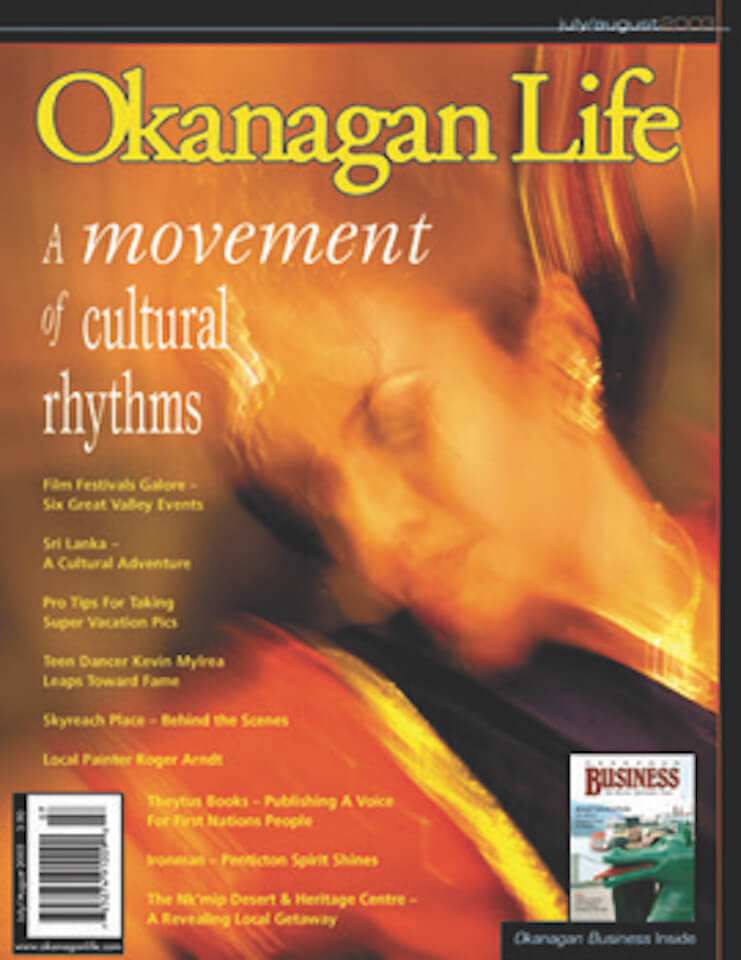
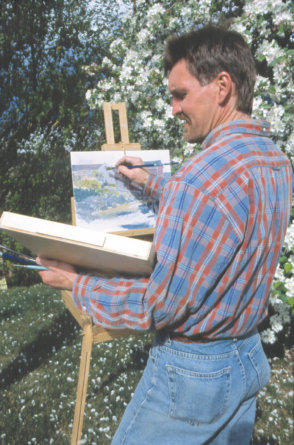 “Painting is all I’ve ever done,” says Roger D. Arndt. He chats easily as though we were sitting down over coffee rather than standing in his Kelowna studio while he brushes tiny branches onto the remarkably detailed trees in his latest landscape.
“Painting is all I’ve ever done,” says Roger D. Arndt. He chats easily as though we were sitting down over coffee rather than standing in his Kelowna studio while he brushes tiny branches onto the remarkably detailed trees in his latest landscape.
Though just entering his mid-forties, Arndt’s life work spans more than three decades and has earned him a widespread reputation as “Painter of the Canadian West.” Roger says he’s been interested in art since he was eight and credits big brother, Allen, with buying him his first oils at 12.
His family has always been involved with his work at some level. Roger’s fascination with the wilderness stems from childhood visits to Manning Park where they hiked and fished and explored. Today, his sister, Sheri, handles framing in the Cherrytree Workshop; Allen does all the art photography and takes care of the business end; and it all happens in a studio complex that was once their grandparents’ homestead.
Roger lays down his brush and picks up a blow dryer. He aims it at the newly painted forest and explains about Genesis heat-set oils. Odourless and non-toxic, these oils will only set at 260 F with the help of a blower (or oven for small pieces).
They don’t dry on his brushes and Roger can mix colours and leave the paint on his palette indefinitely. This allows him to apply one colour, dry it, and immediately carry on with another. Ideal for an artist whose luminous works are crafted with a painstaking layering technique.
But this time he stops to show me around.
We’re standing in a wide-open space with exposed rafters. The walls are hung with Roger’s impressions of the Canadian Rockies; peaceful winterscapes; images reflecting his interest in Haida totems; and his recent return to the seascapes which he first painted as a boy apprentice with Loren D. Adams. Roger remembers what it was like at the farmhouse his grandfather built in 1946.
“There was a bedroom here, the living room was there… and that was the trap door to grandma’s root cellar,” he says, indicating the cut-out in the floor where a curved stairway now descends to an area that’s been excavated to provide Allen with a photography studio. I ask about the highly unusual railing – decorated with a musical score etched into the glass – and learn that it’s Brahms’ Intermezzo in A Major, Opus 118, No 2.
Roger leads me down a hallway to the workshop where the physical process of making his art begins and ends. “There’s a lot of prep work in just doing the board,” he says. The panels are coated with many layers of oil primer then sanded until they’re “like glass.”
Finished paintings line an easel wall, waiting for varnish or drying.
This workshop also houses a silk screen press and the high-tech equipment needed for the process. Roger points out a Sunbeam mixer lying on the counter. “We had to buy my Mom a new one when she gave us this,” he laughs. But there’s nothing funny about the business rationale involved.
“It gives me a lot more exposure –” he says, “gets me into a price range that’s affordable for a lot more people.”
The silkscreen (Serigraph) images are printed on canvas, retouched by the artist, varnished, signed and numbered. Arndt limits most editions to 98.
Recently the enterprising brothers have ventured into the digital world and are now making Giclée prints as well. Film of the original painting is scanned into a computer. The extremely high-resolution image is colour corrected on the monitor and a proof created on an Iris® ink-jet printer.
After Roger makes his final changes and corrections, the file is used to print a small edition. This new technology creates images at a perceived resolution of 1850 dpi by spraying ink droplets about the size of a red blood cell. The result is a print with deeply saturated colour that retains subtle tints and blends and remarkable detail.
On the other end of the photography spectrum, a cluster of tattered black and whites decorates a section of the workroom wall and chronicles the Arndt family history. Allen, who’s taking a break from building a new grape arbour over the front veranda, joins Roger in a tag-team retelling of the story.
Although they were born and raised in Vancouver, the boys were shipped to the Okanagan each summer to help their grandparents. The senior Arndt’s came from Alberta and bought a run-down orchard. They built this house from pine trees on the property and worked hard to improve the place.
“We hated it at the time,” says Allen, “work, work, work all the time. Out at 5:30 to change water (irrigation), hoeing. There was so much work… Grandma had 150 rose bushes!”
Things were very different then. They remember daylong trips out past Big White to cut orchard props. And a lion roaring in the night. Their uncle owned a small zoo in the area now occupied by Canadian Tire and the cat’s roars carried all the way up to the farm on Belgoe Bench. When the cherries began to ripen, they’d help harvest 35 tons of fruit over five or six weeks.
Those trees are gone now. Roger and Allen are currently replanting the orchard with new varieties of cherry and apple. “It’s been an evolution over the years,” says Allen.
The brothers began in 1986 with the original farmhouse, which, typical of homesteads, had become an implement shed and junk area when a new house was built. They gutted the interior and added the north light. Gradually they expanded into the adjoining bays and dug out the cellar.
“It’s been a labour of love – we chip away at it piece by piece,” says Roger.
Allen agrees, adding: “You have to look at it with long eyes.”
In 1997, they added a section, which includes a catering kitchen and large room suitable for concerts, business meetings and small weddings. Out front, a rock garden is taking shape.
Amidst all the activity you’d wonder where Roger finds time to paint and attend shows. But somehow it all happens. He sees the gallery as “more of a studio experience than the ones downtown.” More of his work is on display and he conducts art classes on site.
This time of year is especially hectic. Ripening fruit means more work for the brothers, but a bonus for art lovers. Along with the originals, prints and art cards available in the gift salon (at prices ranging from $3.50 to $2,000), you can plan to take home some fresh-picked cherries or apples.
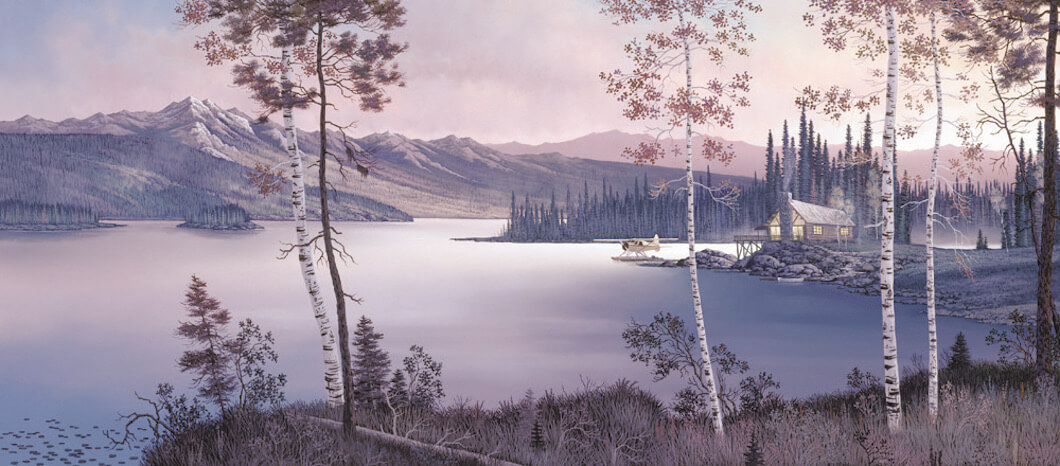
Read more of the original stories celebrated in our 30th-anniversary issue.
Conservation cooperation
2018 OWC COMMUNICATIONS AWARDS WINNER This annual competition recognizes and rewards excellence in outdoor communication. Congrats to Judie Steeves for receiving the Ducks Unlimited Canada Award in Conservation for Conservation Cooperation published in the June 2017...
Helping Syrian refugees find their way in a new world
As seen in our pages. Diddy Evans (centre) felt powerless as she watched the horrors of the war in Syria unfold. “Then I found an opportunity to do something for people who have endured so much,” she says, explaining why she volunteers with a group helping Syrian...
Okanagan Centre for Innovation recognized as Best in BC
Centre awarded Stan Rogers Memorial Award The Okanagan Centre for Innovation was announced winner of the Stan Rogers Memorial Award at the British Columbia Economic Development Association Summit this week in Victoria, B.C. The award recognizes the major project that...
Downtown Vernon: City Centre evolution
Vernon’s historic city centre is buzzing with the kind of renewed vitality that attracts residents and draws visitors.
Recent construction projects update and blend with familiar streetscapes, taking advantage of easy access to the host of retail outlets, restaurants, pro-fessional services, arts and cultural venues already available.
Okanagan literary festival ‘puts Vernon on the map’ with award-winning writers hosting workshops
There’s a novelist who’s written a bestseller about Daniel Boone, a non-fiction writer who voyages to Antarctica, an award-winning playwright whose work is being staged at this moment in Saskatchewan, and a poet whose name is more or less synonymous with creative...
You ate what?!
They’re finally giving astronauts something to make a cheeseburger with—other than flaccid tortillas. Nothing wrong with tortillas, I like them, but cheeseburgers they do not make. Actually, from the NASA handout photos, they look more like the brown rubber gag items...


